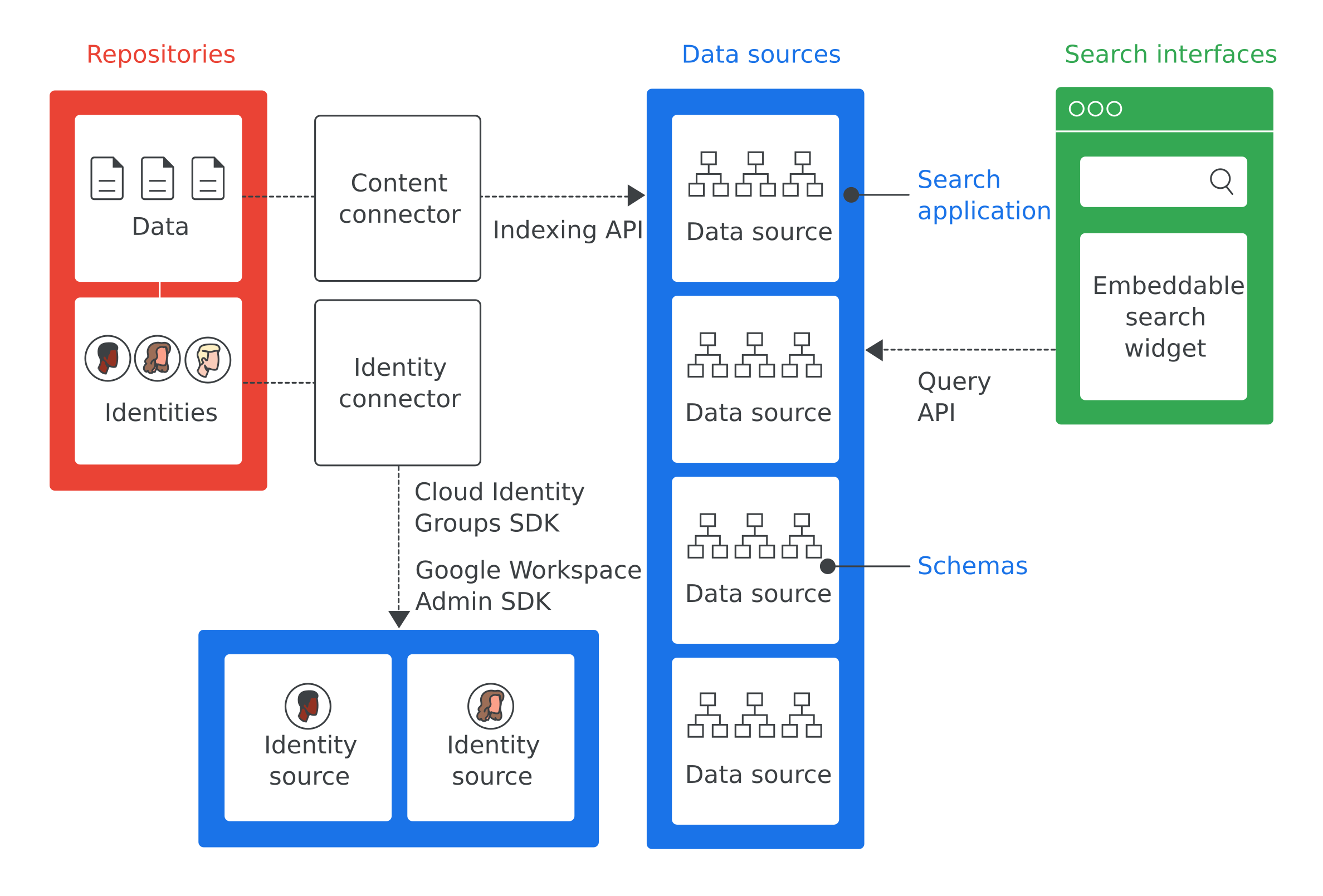Google ক্লাউড অনুসন্ধান একটি কোম্পানির কর্মচারীদের কোম্পানির অভ্যন্তরীণ ডেটা ভান্ডার থেকে অভ্যন্তরীণ নথি, ডাটাবেস ক্ষেত্র এবং CRM ডেটার মতো তথ্য অনুসন্ধান এবং পুনরুদ্ধার করার অনুমতি দেয়৷
স্থাপত্য ওভারভিউ
চিত্র 1 একটি Google ক্লাউড অনুসন্ধান বাস্তবায়নের সমস্ত মূল উপাদানগুলি দেখায়:

এখানে চিত্র 1 থেকে সবচেয়ে গুরুত্বপূর্ণ পদগুলির সংজ্ঞা দেওয়া হল:
- ভান্ডার
- একটি এন্টারপ্রাইজ তার ডেটা সঞ্চয় করতে ব্যবহৃত সফ্টওয়্যার, যেমন কর্মচারী তথ্য সংরক্ষণ করতে ব্যবহৃত ডাটাবেস।
- তথ্য উৎস
- Google ক্লাউড অনুসন্ধানে সূচিবদ্ধ এবং সংরক্ষণ করা হয়েছে এমন একটি সংগ্রহস্থল থেকে ডেটা।
- অনুসন্ধান ইন্টারফেস
- একটি ডেটা উৎস অনুসন্ধান করতে কর্মচারীদের দ্বারা ব্যবহৃত ব্যবহারকারী ইন্টারফেস। মোবাইল ফোন থেকে ডেস্কটপ কম্পিউটারে যেকোনো ডিভাইসে ব্যবহারের জন্য একটি অনুসন্ধান ইন্টারফেস তৈরি করা যেতে পারে। আপনার অভ্যন্তরীণ ওয়েব সাইটগুলির মধ্যে অনুসন্ধান সক্ষম করতে Google-প্রদত্ত অনুসন্ধান উইজেটটিও স্থাপন করা যেতে পারে। অনুসন্ধান অ্যাপ্লিকেশন আইডি প্রতিটি অনুসন্ধানের সাথে অন্তর্ভুক্ত করা হয় যাতে নিশ্চিত করা হয় যে সেই অনুসন্ধানের প্রসঙ্গ, যেমন একটি গ্রাহক পরিষেবা সরঞ্জামের মধ্যে, পরিচিত। cloudsearch.google.com সাইটটিতে একটি সার্চ ইন্টারফেস রয়েছে।
- অনুসন্ধান অ্যাপ্লিকেশন
- সেটিংসের একটি গোষ্ঠী যা অনুসন্ধান ইন্টারফেসের সাথে যুক্ত হলে, অনুসন্ধান সম্পর্কে প্রাসঙ্গিক তথ্য প্রদান করে। প্রাসঙ্গিক তথ্যের মধ্যে ডেটা উত্স এবং অনুসন্ধানের র্যাঙ্কিং অন্তর্ভুক্ত থাকে যা সেই ইন্টারফেসটি ব্যবহার করে অনুসন্ধানের জন্য ব্যবহার করা উচিত। অনুসন্ধান অ্যাপ্লিকেশনগুলিতে ফলাফলগুলি ফিল্টার করার প্রক্রিয়াও অন্তর্ভুক্ত থাকে এবং ডেটা উত্সগুলিতে রিপোর্টিং সক্ষম করে, যেমন একটি নির্দিষ্ট সময়ের মধ্যে করা প্রশ্নের সংখ্যা।
- স্কিমা
- Google ক্লাউড অনুসন্ধানের জন্য একটি এন্টারপ্রাইজের সংগ্রহস্থলে থাকা ডেটা কীভাবে উপস্থাপন করা উচিত তার রূপরেখা একটি ডেটা কাঠামো। একটি স্কিমা কর্মচারী Google ক্লাউড অনুসন্ধানের অভিজ্ঞতাকে সংজ্ঞায়িত করে, যেমন জিনিসগুলি কীভাবে ফিল্টার করা হয় এবং প্রদর্শিত হয়৷
- বিষয়বস্তু সংযোগকারী
- একটি সফ্টওয়্যার প্রোগ্রাম যা একটি এন্টারপ্রাইজের সংগ্রহস্থলে ডেটা অতিক্রম করতে এবং একটি ডেটা উত্স তৈরি করতে ব্যবহৃত হয়।
- পরিচয় সংযোগকারী
- একটি সফ্টওয়্যার প্রোগ্রাম যা Google ক্লাউড অনুসন্ধানের জন্য প্রয়োজনীয় পরিচয়গুলির সাথে এন্টারপ্রাইজ পরিচয় (ব্যবহারকারী এবং গোষ্ঠী) সিঙ্ক করতে ব্যবহৃত হয়৷
Google ক্লাউড অনুসন্ধান ব্যবহার ক্ষেত্রে
এখানে কিছু ব্যবহারের ক্ষেত্রে রয়েছে যা Google ক্লাউড অনুসন্ধান দ্বারা সমাধান করা যেতে পারে:
- কর্মচারীদের কর্পোরেট নীতি, নথি, এবং অন্যান্য কর্মচারীদের দ্বারা লিখিত বিষয়বস্তু খুঁজে বের করার একটি উপায় প্রয়োজন।
- গ্রাহক পরিষেবা দলের সদস্যদের গ্রাহকদের পাঠানোর জন্য প্রাসঙ্গিক সমস্যা সমাধানের নথি খুঁজে বের করতে হবে।
- কর্মচারীদের কোম্পানির প্রকল্প সম্পর্কে অভ্যন্তরীণ তথ্য খুঁজে বের করতে হবে।
- একজন বিক্রয় প্রতিনিধি একটি নির্দিষ্ট গ্রাহকের জন্য সমস্ত সহায়তা সমস্যার স্থিতি দেখতে চায়।
- কর্মচারীরা একটি কোম্পানি-নির্দিষ্ট মেয়াদের জন্য একটি সংজ্ঞা চান।
Google ক্লাউড অনুসন্ধান বাস্তবায়নের প্রথম ধাপ হল Google ক্লাউড অনুসন্ধান দ্বারা সমাধান করা ব্যবহারের ক্ষেত্রে চিহ্নিত করা।
Google ক্লাউড অনুসন্ধান প্রয়োগ করুন
ডিফল্টরূপে, Google ক্লাউড সার্চ Google ডকুমেন্ট এবং স্প্রেডশিটের মতো Google Workspace ডেটাকে ইন্ডেক্স করে। Google Workspace ডেটার জন্য আপনাকে Google Cloud Search প্রয়োগ করতে হবে না। যাইহোক, আপনাকে নন-Google Workspace ডেটার জন্য Google ক্লাউড সার্চ প্রয়োগ করতে হবে, যেমন তৃতীয় পক্ষের ডেটাবেসে সঞ্চিত ডেটা, Windows Fileshare, OneDrive-এর মতো ফাইল সিস্টেম বা Sharepoint-এর মতো ইন্ট্রানেট পোর্টাল৷ আপনার এন্টারপ্রাইজের জন্য Google ক্লাউড অনুসন্ধান বাস্তবায়নের জন্য নিম্নলিখিত পদক্ষেপগুলি প্রয়োজন৷
- Google ক্লাউড অনুসন্ধান সমাধান করতে সাহায্য করে এমন একটি ব্যবহারের ক্ষেত্রে নির্ধারণ করুন৷
- ব্যবহারের ক্ষেত্রে প্রাসঙ্গিক ডেটা ধারণকারী সংগ্রহস্থলগুলি সনাক্ত করুন।
- প্রতিটি সংগ্রহস্থলে ডেটা অ্যাক্সেস পরিচালনা করতে আপনার কোম্পানির দ্বারা ব্যবহৃত আইডেন্টিটি সিস্টেমগুলি সনাক্ত করুন৷
- Google ক্লাউড অনুসন্ধান API-এ অ্যাক্সেস কনফিগার করুন ।
- Google ক্লাউড অনুসন্ধানে একটি ডেটা উৎস যোগ করুন ।
- প্রতিটি ডেটা উত্সের জন্য একটি স্কিমা তৈরি করুন এবং নিবন্ধন করুন ৷
- আপনার সংগ্রহস্থলের জন্য একটি সামগ্রী সংযোগকারী উপলব্ধ আছে কিনা তা নির্ধারণ করুন। পূর্ব-নির্মিত সংযোগকারীগুলির একটি তালিকার জন্য, ক্লাউড অনুসন্ধান সংযোগকারী ডিরেক্টরি পড়ুন। একটি বিষয়বস্তু সংযোগকারী উপলব্ধ থাকলে, ধাপ 9 এ যান।
- প্রতিটি সংগ্রহস্থলে ডেটা অ্যাক্সেস করতে একটি সামগ্রী সংযোগকারী তৈরি করুন এবং এটিকে একটি ক্লাউড অনুসন্ধান ডেটা উত্সে সূচী করুন৷
- আপনার একটি পরিচয় সংযোগকারী প্রয়োজন কিনা তা নির্ধারণ করুন৷ আপনার যদি কোনো পরিচয় সংযোগকারীর প্রয়োজন না হয়, তাহলে ধাপ 11 এ যান।
- আপনার সংগ্রহস্থল বা এন্টারপ্রাইজ পরিচয়গুলিকে Google পরিচয়ে ম্যাপ করতে একটি পরিচয় সংযোগকারী তৈরি করুন ৷
- অনুসন্ধান অ্যাপ্লিকেশন সেট আপ করুন ।
- অনুসন্ধান প্রশ্নগুলি সম্পাদন করতে একটি অনুসন্ধান ইন্টারফেস তৈরি করুন ৷
- আপনার সংযোগকারী এবং অনুসন্ধান ইন্টারফেস স্থাপন. আপনি যদি একটি পূর্ব-নির্মিত সংযোগকারী ব্যবহার করেন তবে সংযোগকারীটি পেতে এবং স্থাপন করতে সংযোগকারীর নির্দেশাবলী অনুসরণ করুন৷ উপলব্ধ সংযোগকারীগুলি Google ক্লাউড অনুসন্ধান সংযোগকারী ডিরেক্টরিতে তালিকাভুক্ত করা হয়েছে৷
পরবর্তী পদক্ষেপ
এখানে কয়েকটি পরবর্তী পদক্ষেপ রয়েছে যা আপনি নিতে পারেন:
- Google ক্লাউড অনুসন্ধান শুরু করার টিউটোরিয়াল চেষ্টা করুন।
- আপনি Google ক্লাউড অনুসন্ধান ব্যবহার করবেন এমন ক্ষেত্রে (গুলি) ব্যবহার করুন।
- এই ব্যবহারের ক্ষেত্রে প্রাসঙ্গিক সংগ্রহস্থলগুলি সনাক্ত করুন।
- আপনার সংগ্রহস্থল দ্বারা ব্যবহৃত কোনো পরিচয় সিস্টেম সনাক্ত করুন.
- Google ক্লাউড অনুসন্ধান API-এ অ্যাক্সেস কনফিগার করা চালিয়ে যান।
